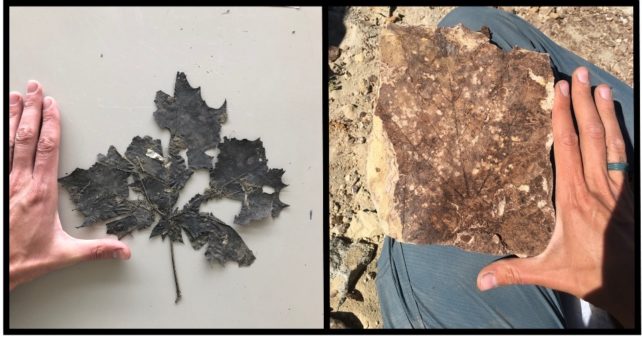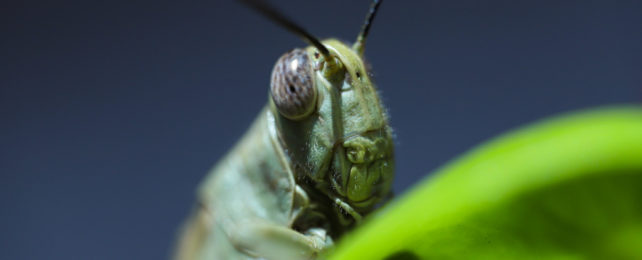For eons, plants and insects have lived in a delicate dance, of pollinators giving life to flowering plants and plants feeding the insect masses. But a new study suggests that insects are feasting on plants more so now than in the past 66.8 million years.
"The difference in insect damage between the modern era and the fossilized record is striking," says University of Maine paleoecologist Lauren Azevedo-Schmidt who led the study.
To look at plant-insect interactions over time, Azevedo-Schmidt and colleagues compared the leaves of modern-era plants sampled from three forests to fossil assemblages of leaf imprints from as far back as the Late Cretaceous period, nearly 67 million years ago.
Quantifying the type and frequency of insect-inflected damage, they found a sharp increase in insect herbivory in recent times, with insects piercing, sucking, hole-punching, and skeletonizing plant leaves.
"We find that despite insect declines, insect damage to plants is elevated in the modern era compared with other time periods represented in the fossil record," Azevedo-Schmidt and colleagues write.
Plants have evolved to quietly dominate life on Earth, with land plants now representing a weighty 80 percent of global biomass. Teensy insects, though small in size, are unmatched in species richness. Both have evidently found ways to adapt to environmental change over millennia, despite being highly sensitive to temperature.
But there is a limit to what they can endure. Some research has suggested insect numbers are declining, at least in some parts of the world. Climate change is also prompting plants to blossom earlier and grow faster, lengthening the pollen season. Not to mention sickening rates of human-caused habitat and biodiversity loss.
The study from Azevedo-Schmidt and colleagues found that leaves carbon-dated from 1955 to present had twice the average amount of insect damage than in any of the 64 fossil assemblages dating back tens of millions of years.

Leaves were collected from two forests in the northeastern United States (one cool, moist forest, and a second, warm, coastal forest) and a third forest in tropical Costa Rica – a biodiversity hotspot dripping with life.
Fossil data was compiled from published datasets spanning latitudes and climates, and stretching from 66.8 million years ago through the Pleistocene to roughly 2 million years ago, before early humans migrated out of Africa.
"We propose that the comparatively rapid warming trends of the [modern] era may be responsible for its higher herbivory frequencies, such that rapid warming benefits insects in the arms race against their food source: plants," Azevedo-Schmidt and colleagues write.
The increased insect herbivory could have unknown consequences for plants and forest communities, the researchers warn.
Of course, the fossil record only captures a sliver of life and snapshot in time, though the researchers did take steps to account for how leaves are preserved. They sampled modern-day leaves from sediment, to mimic fossil outcrops, comparing insect damage on those buried leaves to that of leaf litter and leaf compression fossils.
"A long-term perspective is required to understand these ancient organisms and their longstanding ecological associations, as well as pinpoint where future collecting efforts should focus," the researchers write.
What's clear already is that something has shifted in the seven decades since 1955, the briefest of windows compared to the geological eras that unfolded before we humans started reshaping the biosphere.
Past research, also from the US, for instance, has found markedly more insect damage on herbarium specimens from the early 2000s compared to those collected a decade earlier, a pattern linked to rising temperatures.
It could be that insect feeding is intensifying or that insect populations are locally increasing in the forests studied – which, in the current study, were situated within the grounds of research stations, surrounded by roads, housing developments and farming.
"Perhaps urbanization has created insect biodiversity hot spots within research forests," Azevedo-Schmidt and colleagues write.
A fast-warming climate – which is influencing insect life-cycles and feeding habits, and pushing their range of habitats poleward – and the introduction of invasive species are other big factors that could be driving increased insect herbivory.
At the same time, agriculture is decimating insects and research suggests plants may have to start battling each other to attract pollinators. The situation is dire and human fingerprints are all over the problem.
"This research suggests that the strength of human influence on plant-insect interactions is not controlled by climate change alone but, rather, the way in which humans interact with the terrestrial landscape," they conclude.
The study was published in PNAS.
